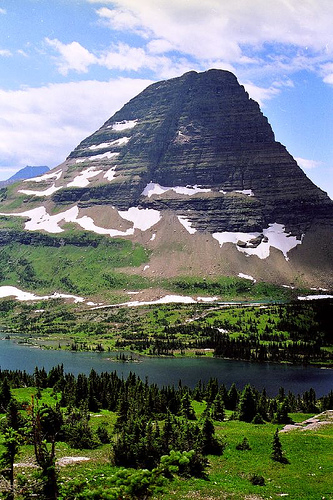Anyone who’s ever lived in a home with a leaky basement knows that during a rainstorm, preventing a flood is the first order of business. Too often, though, it’s easy to put off until later the investments necessary to protect your home from future storms that are sure to come.
The same is true with climate change. Right now, the planet is awash in a rising flood of carbon dioxide that threatens to forever change our marine, forest, grassland, desert, and mountain ecosystems. We see early signs of these changes in national parks throughout the country — the canaries in the coal mine of climate change.
Glaciers are beating a rapid retreat in Glacier National Park, and will be completely gone within 20 years. Heat-sensitive wildlife species like the pika in Yosemite National Park are moving to higher elevations to escape rising temperatures, and may become extinct locally once they can’t go any higher. Trout are disappearing as the cool mountain streams of Shenandoah and Great Smoky Mountains National Parks gradually warm.
Cutting the flood of emissions is the first order of business. If we don’t act now to drastically reduce greenhouse gases, our national parks, the plants, fish, and wildlife that depend on them, and the thousands of communities that benefit economically from related tourism, could suffer irreversible declines.
But like the homeowner with a leaky basement, we also need a longer-term plan to prevent problems from recurring. Unnatural global warming is happening now, and even if we stopped all emissions today, a century’s worth of industrial emissions already in our atmosphere will cause disruptive climate changes for decades to come. That’s why we must act simultaneously to cut global warming pollution and prepare for the ongoing consequences of climate change. Doing one without the other is only half a solution.
Fortunately, congressional leaders are on the right track. Earlier this month, Henry Waxman (D-Calif.) and Ed Markey (D-Mass.) released the American Clean Energy and Security Act of 2009, a bill that would lower greenhouse gas emissions, create thousands of clean energy jobs, and safeguard our air, water, land, and wildlife from climate changes already underway.
Last year, the Senate Environment and Public Works Committee approved the Climate Security Act, originally authored by Joe Lieberman (I-Conn.) and John Warner (R-Va.), a bill that would have cut emissions and invested at least $7 billion per year in safeguarding our natural resources from climate change. More recently, the House Natural Resources Committee introduced the Climate Change Safeguards for Natural Resources Conservation Act — legislation that will create a coordinated national plan for safeguarding the air, water, and wildlife that are critical both for our national parks and for the health and welfare of our communities.
As with our own homes, it takes steady investments to ensure that natural systems continue to function in the face of threats like climate change. To protect a basement from floods, you might seal the walls, divert rainwater runoff, and keep gutters clear. But how exactly do we safeguard plants, fish, and animals from climate change?
There’s still much to learn about how climate change is altering our world, but national parks are already working to help wildlife and human communities cope with change. In Everglades National Park, restoration of natural water flow in the “river of grass” is helping many threatened and endangered species like the Florida panther. It is also providing drinking water and enhanced storm protection to many Florida communities threatened by salt intrusion and more destructive hurricanes linked to climate change. In California’s Redwood National Park, streams and forests devastated by years of logging are being restored. This will help trees, fish, and wildlife better cope with stresses brought on by climate change, including drought, wildfire, and pests. It will also provide salmon habitat and cleaner drinking water, both important economic values for surrounding communities.
It’s tempting to think that we could find a little extra money in the federal budget every year to counter the effects of climate change on our natural resources. History doesn’t support this kind of optimism. The national parks, for instance, have been operating with insufficient annual funding and a multi-billion-dollar backlog of maintenance and preservation projects for decades.
Congressional leaders are demonstrating great foresight by writing legislation that would provide dedicated annual funding for dealing with the consequences of climate change. Last year’s Lieberman-Warner bill, and this year’s Waxman-Markey bill, would invest proceeds from the sale of greenhouse gas emissions permits in a cap and trade system back into urgent needs, such as helping consumers and industry switch to cleaner energy and safeguarding America’s communities and natural resources from climate change.
Within the coming weeks, the House Energy and Commerce Committee will determine just how much revenue will be allocated for each purpose. The National Parks Conservation Association, along with dozens of state and federal conservation organizations, tribal organizations, outdoor industries, hunters, and anglers, supports dedicating a small percentage of the permit value to safeguard the natural systems – no less than 5 percent per year out of the estimated hundred billion dollars per year that will be generated on average over the life of the climate bill.
These investments aren’t just good for wildlife-they help build local economies. According to a 2006 study by the Outdoor Industry Association, fishing, hunting, wildlife watching, hiking and other outdoor pursuits that depend on healthy ecosystems contribute $730 billion annually to the U.S. economy. One out of every 20 jobs in this country is linked to wildlife related activities, goods, and services and these activities stimulate 8 percent of all consumer spending. Additionally, a 2006 economic study commissioned by the National Parks Conservation Association revealed that America’s National Park System generates more than four dollars in value to the public for every tax dollar invested by the federal government.
Most homeowners presented with this kind of return on investment would gladly put a little money aside today to keep their homes secure in the years ahead. Our national parks deserve no less.



